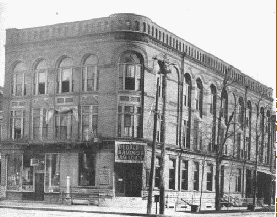|
People's Federal Savings & Loan Assn. - 1918
Architecturally, the bank features
clear-cut lines terminated with a flat roof and bold cornice. The building is dominated by
a Syrian arch at the entrance with blue glass mosaic in the tympanum. Sullivan’s
terra cotta relief ornamentation is punctuated by lion’s head gargoyles (decorative
rain spouts). To give the business a spacious and well-lighted interior, Sullivan designed
within the building’s west wall a continuous string of windows composed of subdued
green glass, accented by occasional ornamental designs in tomato and pale amber glass. The
interior of the building, with its safe symmetrically located, and in full view by all,
offers the comforting presence of security.
By the time Peoples was constructed, Sullivan’s ‘honesty in
architectural design’ was no longer popular. It had been replaced by a Classical
Revival. Sullivan refused to compromise his convictions and design in popular classical
style. His career was limited to commissions in small Midwestern towns such as Sidney,
designing primarily banks. Now, this building is considered to be one of Louis
Sullivan’s finest works and is his only unaltered bank building remaining in Ohio.
Banking began at an unknown time in Shelby
County, Ohio, and it existed in the form of a prosperous pioneer citizen long before any
outside financier formally announced itself a place of safe deposit of secured loans. It
is believed that in the 1850s, a man (Mr. Clark) from Urbana came to Sidney and apparently
opened a bank, although there is no evidence as to how long this operation lasted. John Carey erected Sidney’s first bank building
(Carey’s Hall) in 1854. These locally-owned banks and savings would later become part
of the state and national bank
complexes.
Looking south from the Courthouse, located at the corner of South Ohio
and Court Street, is the Peoples Federal Savings & Loan Association, a National
Historic Landmark. Peoples was incorporated in 1886. After two relocations in five years,
the bank contracted with the A.J. Robertson estate to buy the site of the former Robertson
Marble Works at its current address of 101 East Court Street. The Altenbach firm then built a new facility.
For 35 years the Association prospered, becoming the wealthiest financial institution in
the county.
The bank’s board of directors, led by founder, L.M. Studevant, wanted to own a building,
but also needed it to be fire-proof. There were no properties available for sale downtown.
Since relocating from the square was not an option, remodeling of the current building was
considered. Remodeling was found, however, to be just as expensive as constructing a new
building. The board then made a highly controversial decision and bought the Robertson
block, tearing down the building which they had originally occupied.
In 1917, within a month after the purchase, famed architect Louis H.
Sullivan came to Sidney to make preliminary sketches for the bank. A young American, born
of an Irish father and Swiss-French-German mother, Louis Henri Sullivan is regarded as
perhaps America’s greatest architect. He established his career as one of several
architects hired to totally rebuild downtown Chicago after the catastrophic fire of
1871. He was among the pioneers in the development of the skyscraper, made possible with
the introduction of the skeletal grid iron frame.
It has been said that Sullivan stipulated that the institution accept
the plans exactly as he designed them, without any changes. After five days of submitting
the plans, there were no changes and construction began. The new ‘Thrift’
building was completed only a year later, on May 31, 1918.
In October of that year, American Architect published an article
discussing the new bank building. According to the author, "...a new building from
the hand of Louis Sullivan was an event in architecture...If so much space has been given
the little building that glows like a jewel on its much mooted corner, it is because it
marks a departure from the day of mere utilitarianism...which may... influence the future
of Sidney..."

The original People's building shown below was torn down to make room for
Louis Sullivan's
structure which stands on the same site today.
'Downtown'
segment written in October, 1998 by Sherrie
Casad-Lodge
[ Back to Downtown Index ]
|

